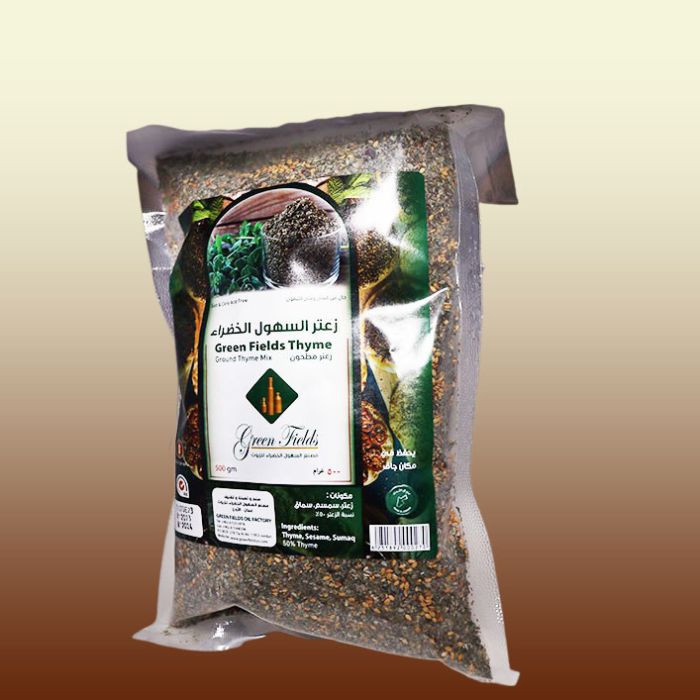
- without additives
- laboratory tested
- Ships within 24 hours worldwide
- *Request a bulk quote email info@greenfieldsjo.com
- Whatsapp: 00962777425666

Green Fields Zaatar Thyme Mix
| SKU | 674-1 |
|---|---|
| Weight | 0.350000 |
| Brand | Green Fields |
The Hidden Truth Behind Commercial Zaatar Production
While zaatar remains a cherished seasoning in many kitchens, the truth behind its commercial production is often less savory. This exploration reveals how some companies compromise the integrity of zaatar, potentially misleading consumers and affecting the quality of the product.
Altered Ingredients: Adding Wheat and Branches
One common practice in the commercial production of zaatar is the addition of fillers like wheat and branches. These fillers are used to bulk up the product, increasing the quantity but severely compromising the quality. Wheat, though it may seem harmless, dilutes the authentic flavor of zaatar. Branches, on the other hand, are more insidious, adding no culinary value and potentially introducing unwanted flavors and textures.
The Heat Factor: Compromising Quality for Durability
The traditional preparation of zaatar involves delicate handling to preserve the integrity and flavor of the herbs. However, in an effort to extend shelf life and enhance durability under heat, commercial producers often overheat zaatar during processing. This excessive heating not only diminishes the natural aroma and taste but also alters the herb's beneficial properties.
The High-Heat Tolerance Myth
Many store-bought zaatar blends boast high-heat tolerance, a characteristic that might seem beneficial at first glance. However, this so-called "benefit" is often a result of the inclusion of non-traditional ingredients designed to prevent burning. True zaatar, made exclusively from thyme and other natural ingredients, is sensitive to heat and requires careful cooking, particularly when used in pastries, as it could give a burning taste.
Traditional Zaatar: A Delicate Craft
Traditional zaatar, like the one we produce, honors the herb's natural characteristics. When used in pastries, our zaatar is added midway through the baking process to avoid burning. This careful application contrasts sharply with commercial zaatar, which often endures high temperatures without apparent damage, misleading consumers about its true quality.
Our Commitment to Producing Real Products
In our approach, we preserve the traditional essence of zaatar. We avoid the use of fillers like wheat and branches, ensuring that our customers receive a product that is both genuine and of the highest quality.
In the end..
The commercial production of zaatar has strayed from its roots, often resulting in a product that bears little resemblance to the traditional blend. As consumers, awareness and understanding of these practices are crucial. By choosing authentic zaatar, like ours, customers can experience the true flavor and quality of this timeless seasoning, while supporting practices that honor the culinary heritage it represents.
The History of Zaatar: A Culinary Journey Through Time
Have you heard the one about the thyme traveler? It went back four seasons and still couldn't find a better herb than zaatar! In a more serious vein, zaatar, a blend of herbs, sesame seeds, and sumac, has a rich history that spans centuries. This essay will delve into the historical journey of zaatar, its evolution, and how we, in our unique approach, have refined the art of making this iconic seasoning.
Ancient Beginnings
Zaatar's story begins in the ancient Middle East. Historical records suggest that zaatar, primarily made from wild thyme, was more than just a culinary ingredient; it was a key component in medicinal practices. The Ancient Egyptians used thyme for embalming, and the Greeks bathed in it for its purifying properties.
The Evolution of Zaatar
As centuries passed, zaatar evolved. By the Middle Ages, it had become a staple in Middle Eastern cuisine. The blend, initially just wild thyme, began to incorporate other ingredients like sesame seeds and sumac, each bringing its unique flavor and health benefits.
The process of making zaatar also saw significant changes. Initially, thyme was simply dried and mixed with other ingredients. However, as culinary practices developed, so did the methods of preparing zaatar. The introduction of toasting sesame seeds, for instance, added a nutty depth to the mix.
Zaatar in Cultural Context
Zaatar has always been more than just a seasoning. In many Middle Eastern cultures, it is a symbol of hospitality and tradition. It's commonly served with bread and olive oil, a simple yet profound gesture of welcome. This tradition has been passed down through generations, making zaatar a timeless link to cultural heritage.
The Science Behind Zaatar
Recent studies have highlighted the health benefits of zaatar. Thyme, rich in vitamins and antioxidants, is known for its anti-inflammatory properties. Sesame seeds add not only flavor but also a healthy dose of minerals. Sumac, with its tangy flavor, is celebrated for its digestive benefits.
Zaatar in the Modern World
Today, zaatar has crossed borders and become a beloved ingredient worldwide. In cooking... from sprinkling on bread and salads to seasoning meats.. has made it a global favorite.
Our Unique Twist on Tradition
We stand out with our unique approach to making zaatar. We begin by gently brushing the thyme leaves with olive oil, a method that enhances the herb's natural flavors. The leaves are then carefully crushed, ensuring the preservation of their aromatic oils. Toasted sesame seeds and sumac are added, creating a blend that's rich in tradition yet distinctly modern.
In the end..
From ancient medicinal uses to a modern kitchen staple, zaatar has stood the test of time. Its evolution is a testament to the enduring power of culinary traditions. Our method of incorporating olive oil and carefully selected ingredients has added a new chapter to the zaatar story, one that honors its rich history while embracing different tastes. Zaatar is not just a mix of herbs and spices; it's a legacy of flavors, a bridge between the past and present, and a celebration of culinary brilliance.



